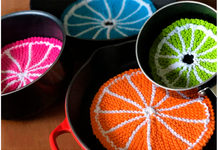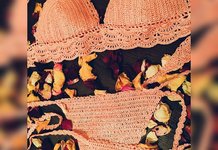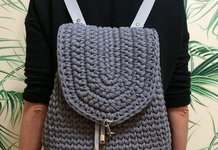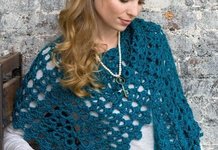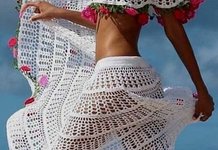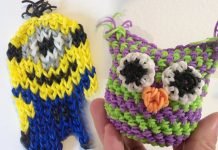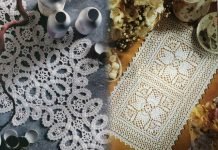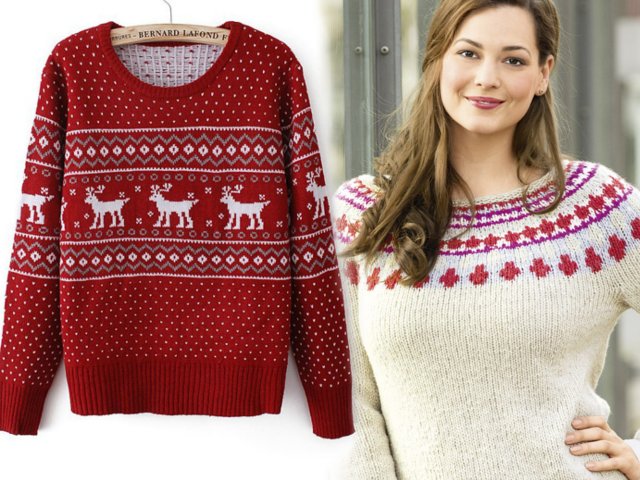
Jacquard patterns are a very popular style of knitting warm clothes, which the older generation recalls with nostalgia, and young people are happy to prove that this is an ageless classic for all cold times.
Feature of the jacquard pattern - repetition of the same pattern made in contrasting colors throughout the entire knitting. In addition, the pattern in this style can be only one for the entire product, as is often the case with children's knitting.
In knitting a jacquard pattern there are no "tricky" loops and extremely complex plexuses, although some ornaments are really difficult to perform, especially for beginner needlewomen. Experienced knitting needles like jacquard patterns for the ability to combine a variety of motifs, and often make up their own unique ornaments.
The classic ornament is known to everyone: deer, Christmas trees, snowflakes, rhombuses and braids. Professionals call it Norwegian patterns and meander ornaments. Therefore, jacquard patterns are often chosen for warm sweaters, socks, hats, mittens, pullovers, scarves. “Funny” motifs with animals and plants look equally great on adults, adolescents, and children. And how they cheer up and complement the festive atmosphere in the New Year's bustle!
Knitting patterns of jacquard patterns with patterns and description
Jacquard patterns are knitted according to counting patterns, in which one cell is one loop, and each sign is a specific thread color. Patterns are knitted according to the scheme from bottom to top.
What are the features of knitting jacquard patterns? They knit with the front surface, and the threads of the desired color should be used both in the front and in the back loops. Thus, on the front side, the pattern we need will appear, and on the wrong side characteristic broaches and weaves of yarn will appear. Edge loops in multi-colored rows are knitted in two colors at the same time.
There is a method that describes how to knit a jacquard pattern without broaches. Consider it with a simple jacquard pattern.
Classic snowflake knitting without broaches

For work you will need:
We take 2 threads contrasting in color with each other.
The threads along the entire length should be made of the same high quality yarn. It is important to make sure that the thread colors do not fade.
Working process:
We knit 23 loops and two more hem, we will end up with 25. The first row of the pattern is knitted in the wrong way, only with blue yarn. The final hem loop is knitted simultaneously in two thread colors. Further, when the work with subsequent rows will occur, it is necessary to knit the edge loops in the same way as described above.
This method will allow you to save the stretch of thread along the edges of the product and will not allow the formation of vertical broaches.Starting to knit the front row, it is necessary to remove the edge loop. Now two threads will be involved simultaneously, which should alternate.

In the diagram, you can see that the first loop is knitted in yellow. To knit without broaches, this thread is seized on the other hand, imitating the knitting of blue yarn, although it is closer. We knit this loop and pull up two threads so that the product is of good density.

Then we start knitting in blue. This thread is located a little further from the knitting needle than yellow yarn. To create this loop, you need to hold the knitting needle to the right under the yellow, capturing the blue and knitting it. After each loop formation, the thread should be tightened.
The following actions will be simple, relying on the diagram drawing and avoiding broaches, follow the same rules as described above. Be sure to knit the edge loops with two threads at once. Observing such not tricky rules, you can associate a beautiful and dense product with a beautiful pattern. In the presented photos, you can see the back and front side of the knit.
Simple patterns for beginners
Jacquard patterns are considered quite simple among other methods of knitting, but even among them there is a separate special category for beginners - simple. To make it easier for beginner knitters, we have put together simple jacquard patterns with knitting needles, patterns and descriptions of which are more than accessible.
Jacquard zigzag

This two-tone zigzag is knitted according to the following simple description:
Rapport of 16 loops + 2 hem.
In height, pattern from 3 to 14 rows.

Two-color jacquard pattern of inclined loops

Pattern Description:
Rapport 3 loops + 1 loop for balance + 2 edge
- 1st row: (thread A) front loops.
- 2nd row: (thread B) * 2 wrong, remove 1 loop - the thread before work, * 1 wrong.
- 3rd row: (thread B) 1 front, * transfer 1 loop to the auxiliary knitting needle before work, 2 front, knit the front loop from the auxiliary knitting needle *
- 4th row: (thread A) 1 wrong side, * 1 loop to remove - the thread before work, 2 wrong side, *
- 5th row: (thread A) * transfer 2 loops to the auxiliary knitting needle at work, 1 front knit, knit the facial loops from the auxiliary knitting needle * 1 front.
- 6th row: repeat from the second row.
Drawing for children
Jacquard patterns for knitting needles for children are also rich in a variety of patterns. It can be as simple cartoon pictures embroidered on sweaters, hats, mittens, socks, and thematic patterns for all occasions.
Openwork Christmas trees

Pattern report of 12 loops. It is necessary to repeat the pattern according to the scheme from the 1st to the 20th rows. In the wrong rows of loops knit according to the pattern of the fabric, the crochets are purl. Knit two loops together front with a slope to the right. The pattern looks good in both dark and light colors.
We knit according to the scheme:

Jacquard fox pattern

To connect one or more fox patterns to 32 loops, you need:
Knit front stitch according to the counting scheme from individual cubes. In the presented diagram, only the front rows are shown. In the wrong rows, knit according to the pattern. When changing colors, constantly cross the threads on the wrong side. This is necessary so that holes do not form.
Act according to the scheme:

Lazy jacquard patterns
Another variety of simple jacquard patterns is lazy. This is often the simplest repeating ornament. Many lazy patterns are knitted according to the principle: every two rows of the same color, after which the tangle changes. The pattern itself is born after stretching the loops from other rows. Here are some lazy jacquard knitting patterns with patterns.
Lazy jacquard stripes

The diagram shows the front and back rows. Letters denote the colors of the thread.
Repeat the rapport in height from 1 to 22 row. Rapport in width 2 loops + 1 loop before rapport + 1 loop after rapport + 2 edging.

Explanations for knitting with a lazy jacquard pattern:
Each row is knitted with a thread of the main color, while the loop corresponding to a thread of a different color is not knitted, but removed, the working thread remains behind the loops.In knitted "lazy" patterns, each loop, each row is listed in strict order. Having knitted the indicated number of rows, they return to the first and all operations are repeated.
Only front rows are indicated in the diagrams, since the backs in all patterns of this type are knitted according to one rule: the loops knitted in the previous odd row are knitted in the same color, and the loops removed in the previous row are removed again without knitting, moreover, the working thread should go over the loops.
The letters A and B opposite the first rows of the diagram indicate the color of the thread, which knits two paired rows: front and wrong. For example, the 1st and 2nd rows are knitted with a thread of color A, while the loop indicating color B is removed, the thread on the front side remains at work, on the wrong side - before work. Next, the thread colors alternate every two pairs of rows.
Patterns begin with knitting the pattern, so the two initial rows need to be connected with a thread of color B. If desired, not two, but more colors of yarn can participate in the pattern, but the principle of alternating colors remains unchanged.
Lazy Jacquard Honeycombs

To knit this pattern, yarn of two colors is used. Each two rows are knitted in one color according to the following scheme with a description:

Sweater Patterns
A jacquard sweater is a winter hit for all time, because such things never go out of style. Many people already associate sweaters with snowflakes, deers, Christmas trees and all kinds of geometric shapes precisely with the New Year holidays, along with the “Irony of Fate”, champagne and the smell of mandarin. We offer several options for patterns with descriptions of knitting sweaters with a jacquard pattern.
Classic deer sweater

Sweater sizes: 42, 44, 46, 48 and 50.
Suitable for sweaters: Sisu yarn (wool 80%, nylon 20%). Yarn consumption for each of the sizes: 350, 400, 400, 450 and 450 g of a light shade and 100 g of a dark shade. Circular knitting needles number 2 and 3.5 are required.
The density of the knit is twenty-seven loops - ten centimeters.
We knit a jacquard pattern according to the following detailed pattern:

The first is knitting the front and back. At the initial stage, you need to dial on circular knitting needles under the second number a certain number of loops of light yarn, respectively 220, 244, 264, 288 and 308. Next, the elastic is knitted two by two in a series of two face and two wrong elements (for the first three sizes - 6 cm, for the remaining two - 7 cm).
After that, you have to change the knitting needles to the third number and knit based on the faces. smooth. Having connected forty-one centimeters, the loops are divided into two parts for the front and back (100, 112, 122, 134 and 144 links). Among these loops you need to close ten for the armhole. Now they can be left for a while.
To create sleeves for reindeer sweaters, action plan this: make a set of so many loops of light yarn (knitting needles No. 2): 52, 56, 60, 60 and 64. Then there is a circular knitting of an elastic band two by two, 6 cm long for sizes 42, 44 and 46 and 7 cm - 48 and 50. The next stage is the transition to the knitting needles under the third number. In the first row you need to add 5, 5, 9, 7 stitches = 57, 61, 65, 69 and 71 stitches. Next is the front surface.
To expand the sleeve, a uniform number of links is added, namely 28 for all sizes except the last fiftieth, in this case their number will be 32 pieces. Then comes the addition of one loop in all tenth rows on both sides of the first. Through 47, 47, 48, 48 and 48 cm on the knitting needles: 85, 89, 93, 97 and 103 buttonholes. Further, the first link on the fifth from each side of it (a total of eleven) is closed for the armhole. The remainder, respectively: 74, 78, 82, 86, 92 links (they are postponed).
The next step in knitting a deer sweater will be to create a yoke using circular knitting needles number three, where the deferred links are placed (= 348, 380, 408, 440, 472). Knit line “A” according to the pattern. When reaching the fifth row, it is worthwhile to uniformly decrease the elements: 28, 28, 24, 24 and 24 = 320, 352, 384, 416 and 448.
Now, according to the scheme, segment “B” is knitted. Pay attention, the arrow indicates the desired size. Reducing links occurs as indicated by the circuit (this is necessary to narrow the sweater).After you knit to a certain mark, put in an extra knitting needle. This tool removes the middle twenty-two buttonholes in front and on the back. Those links that remain are knitted as front and back rows until the end of segment "B" in the diagram.
Having finished knitting segment “B” on the tools, you should form the following number of links: 172, 184, 196, 212 and 228, taking into account the loops from additional knitting needles. Next is the knitting of segment "C". At the end, proceed to a uniform decrease: 52, 56, 60, 64 and 68. Now you can go to the knitting needles under the second number.
The last thing in knitting a sweater with deer is knitting a two-by-two-elastic gates based on: 16, 16, 17, 18 and 18 cm. The final step is to close all the loops and sew the sleeves into the armholes.
Cute knitting sweater with a deer for a child

Dimensions: 2/4/6 / 8-10 / 12 years.
For knitting with a jacquard sweater you need: 3/3/4/4/5 skeins of turquoise Piscine, 1/1/1/1/2 skeins of cream Sable yarn Phil Frenesie (37% cotton, 26% wool, 15% polyamide, 12% mohair, 130 m / 50 g ) 1/1/1/2/2 skein of dark gray Touareg Partner 3.5 yarn (50% polyamide, 25% acrylic, 25% wool; 50 g / 125 m). Knitting needles number 3,5 and number 4.
Rubber: alternately 1 persons., 1 out.
Facial surface: persons. R. - persons. n., out. R. - out. P.
Jacquard Pattern: knit faces. stitch according to the counting scheme. When changing colors, cross the threads on the wrong side so that no holes appear.
Knitting density
Facial surface, thread Phil Frenesie, knitting needles No. 4: 19 p. And 28 p. = 10 x 10 cm.
Jacquard pattern, knitting needles No. 4: 41 p. And 30 p. = 20 x 10 cm.
Description of knitting a pullover according to the following schemes:


Back: on knitting needles No. 3.5 with a Piscine thread, dial 60/66/72/78/88 p. and knit 2 cm (= 6 p.) with an elastic band. Go to the number 4 knitting needles and knit faces. stitch, adding 1 p. = 61/67/73/79/89 p. After 20.5 / 22.5 / 24.5 / 28 / 31.5 cm (= 58/64/68/78/88 p. ) from gum for armholes to close on both sides 1 x 2 p., then in each 2 r. 1 x 2 p. And 2 x 1 p. = 49/55/61/67/77 p.
After 32.5 / 36.5 / 40.5 / 45.5 / 51.5 cm (= 92/102/114/128/144 p.) From the gum for shoulder bevels, close on both sides 1 x 3 p. / 1 x 3 p. / 1 x 4 p. / 1 x 4 p. / 1 x 5 p. And in each 2nd p. 3 x 3 p. / 1 x 3 p., 2 x 4 p. / W x 4 p. / 1 x 4 p., 2 x 5 p. / 1 x 5 p., 2 x 6 p. At the same time for cutout to close the middle necks 9/9/9/11/11 p. and knit further separately, closing along the edges of the neckline in every 2 r. 2 x 4 p. / 1 x 5 p., 1 x 4 p. / 2 x 5 p. / 2 x 5 p. / 1 x 6 p., 1 x 5 p.
Before: on knitting needles No. 3.5 with a Piscine thread, dial 60/66/72/78/88 p. and knit 2 cm (= 6 p.) with an elastic band. Go to the knitting needles No. 4 and knit with a jacquard pattern according to the corresponding pattern, adding evenly in the 1st p. 5/5/5/7 / E p. = 65/71/77/85/97 p. After 20.5 / 22.5 / 24.5 / 28 / 31.5 cm (= 62/68/74 / 84/94 p.) From gum for armholes close 1 x 2 p. On both sides, then in each 2nd p. 1 x 2 p. 2 x 1 p. = 53/59/65/73/85 p.
After 29.5 / 33.5 / 36.5 / 41.5 / 46.5 cm (= 88/100/110/124/140 p.) From the rubber for the neckline, close the middle 9/9/9/11 / 11 p. And knit further separately, closing along the edges of the neckline in each 2nd p. 1 x 3 p., 2 x 2 p., 2 x 1 p. / 2 x 3 p., 1 x 2 p., 2 x 1 p. / 1 x 4 p., 1 x 3 p., 1 x 2 p., 2 x 1 p. / 1 x 4 p., 1 x 3 p., 1 x 2 p., 2 x 1 p. / 1 x 4 p., 1 x 3 p., 2 x 2 p ., 1 x 1 p.
Sleeves: on knitting needles No. 3.5 with a Piscine thread, dial 36/38/40/44/46 p. and knit 2.5 cm (= 8 p.) with an elastic band. Go to the number 4 knitting needles and knit faces. stitch, adding 1 p. = 37/39/41/45/47 p. Add on both sides in each 12th p. 2 x 1 p., In every 10th p. 2 x 1 p. / After 10 p. 1 x 1 p., In each 8th p. 6 x 1 p. / In each 8th p. 6 x 1 p., In each 6th p. 4 x 1 p. / In each 8th p. 11 x 1 p. / In each 8th p. 7 x 1 p., In each 6th p. 8 x 1 p. = 45/53/61/67/77 p.
After 19 / 23.5 / 28/34 / 39.5 cm (= 54/66/78/94/110 p.) From the elastic for the sleeve, close on both sides 1 x 3 p. / 1 x 4 p. / 1 x 4 p. / 1 x 4 p. / 1 x 5 p., Then in each 2nd p. 2 x 2 p., 2 x 1 p., 2 x 2 p., 1 x 3 p. / 1 x 3 p., 1 x 2 p., 2 x 1 p., 1 x 2 p., 1 x 3 p., 1 x 4 p. / 2 x 3 p., 2 x 2 p., 2 x 3 p., 1 x 4 p. / 1 x 4 p., 2 x 3 p., 1 x 2 p ., 1 x 3 p., 2 x 4 p. / 2 x 4 p., 2 x 3 p., 2 x 4 p., 1 x 5 p. After 25 / 29.5 / 34/40/45, 5 cm (= 70/82/94/110/126 p.) From the elastic band close the remaining 13 p.
Neckline: on knitting needles No. 3.5 with a Piscine thread, dial 70/74/80/84/90 p., knit 2 cm (= 6 p.) with an elastic band, 1 person. R. persons. item and several rows of persons. smooth surface contrasting thread. Iron these rows and dissolve them during assembly to the main thread.
Assembly: perform shoulder seams, side seams and sleeve seams. Stitch sleeves. Sew the bar to the cut with a stitch seam from the faces. side.
Video lesson
To help beginners knit the jacquard pattern with knitting needles, you can use the help of professional knitters who show in detail each manipulation of knitting needles with threads. Such a Norwegian motif will look great on women's, men's and children's clothes. It is especially convenient that this jacquard pattern fits in a circle, and it turns out without broaches.
Video: how to knit a beautiful jacquard pattern with knitting needles



